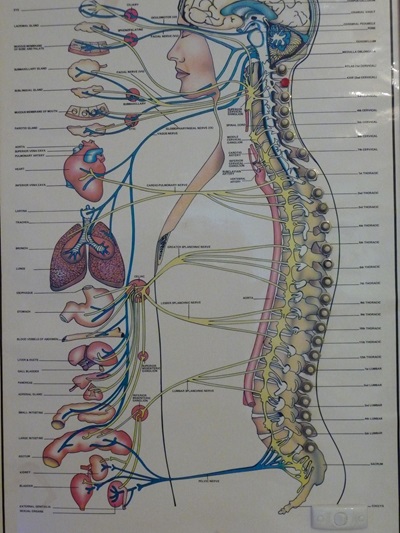This medical research negates the medical-inspired ban on chiropractors caring for symptoms of the autonomic nervous system!

 Sympathetic Segmental Disturbances
Sympathetic Segmental Disturbances
The Evidences of the Association, in Dissected Cadavers, of Visceral Disease with Vertebral Deformities of the Same Sympathetic Segments Medical Times, November 1921, pp. 1-7
Henry Winsor, MD
THIS AUTHOR NOTES:
“The object of these necropsies was to determine whether any connection existed between minor curvatures of the spine, on the one hand, and diseased organs on the other.”
This author used 50 cadavers from the University of Pennsylvania.
49 of the 50 cadavers displayed minor curvatures of the spine, and 1 cadaver displayed the normal “slight smooth lateral curve in the thoracic spine.”
This 1 cadaver still showed “very minor visceral pathology in the segments immediately above and below the reported curve,” at “segments which should form compensatory curves.”
“All [other] curves and deformities of the spine were rigid, apparently of long duration; irreducible by ordinary manual force: extension, counter-extension, rotation, even strong lateral movements failed to remove them or even cause them to change their relative positions.”
Importantly, minor spinal curvatures “their association with disease of organs belonging to the same sympathetic segment is more frequent than with gross curves.”
Also importantly, in the 4 spines with gross curvatures “diseased organs were not found to belong to the same sympathetic segments as the gross curves, but were [found at] the same sympathetic segments as the minor compensatory curvatures above and below the greater curves.”
Visceral Disturbance Vertebral Curvatures Of The Same Sympathetic Segment As Visceral Trouble Sympathetic Connections Between Vertebrae And Diseased Organs
Diseased Thymus #2 C7, T1 #1 T-2-3-4 #1
Inferior Cervical Sympathetic Ganglia
Adhered Pleurae #21 Upper Thoracics #19
Lower Thoracics #2
Upper Thoracic Ganglia
Lower Thoracic Ganglia
Lung Diseases #26 Upper Thoracics #26
Upper Thoracic Ganglia Heart & Pericardium Diseases #20
T1-2-3-4-5 #18 C7, T1 #2
Upper Thoracic Ganglia
Inferior Cervical Ganglia
Stomach Diseases #9 T5-6-7-8-9 #8
An Adjacent Segment #1
Greater Splanchnic From Thoracics 5-9
Liver Diseases #13 T5-6-7-8-9 #12
An Adjacent Segment #1
Greater Splanchnic From Thoracics 5-9
Gall Bladder Disease #5 T5-6-7-8-9 #5 Greater Splanchnic From Thoracics 5-9
Pancreas Disease #3 T5-6-7-8-9 #3 Greater Splanchnic From Thoracics 5-9
Spleen Diseases #11 T5-6-7-8-9 #10
T10-11-12 #1
Greater Splanchnic From Thoracics 5-9
Lesser Splanchnic Nerves
Inguinal Diseases #2 T12 #2 Ilio-inguinal Nerve
Kidney Disease #17 T10-11-12 #14
T5-6-7-8-9 #1
L1-2 #2
Least, Lesser & Greater Splanchnic Nerves
Upper Lumbar Ganglia
Prostate & Bladder Disease #8
L1-2-3 #7
T12 #1
Upper Lumbar Ganglia
Last Thoracic Ganglia
Uterus Diseases #2 Lumbar Lordosis #2 Lumbar & Sacral Ganglia
Total Visceral Diseases #139
Vertebral Curve Of Same Sympathetic Segment As Disease Site #128
Vertebral Curve Of Adjacent Segment #10
“Therefore, in 50 cadavers with disease in 139 organs, there was found curve of the vertebrae, belonging to the same sympathetic segments as the diseased organs 128 times, leaving an apparent discrepancy of 10, in which the vertebrae in curve belonged to an adjacent segment to that which should supply the diseased organs with sympathetic filaments.”
The author then notes that the ten “apparent discrepancies from adjacent segments” can be accounted for by “nerve filaments leaving the spinal cord and traveling for a few segments.”
The author then states that if he included the cadaver with “faint curve and slight visceral pathology” that the correlation was 139 out of 139 for 100%.
Importantly, the types documented include:
Larynx cancer, fatty degeneration of the thymus, pleural adhesions, pleural effusions, pneumonia, tuberculosis, pulmonary edema, pulmonary congestion, lung fibrosis, bronchitis, enlarged lymph nodes, influenza, heart endocarditis, heart dilatation, heart muscle degeneration, pericarditis, aortic aneurysm, liver cirrhosis, liver swelling, liver tumors, enlarged spleen, atrophied spleen, inflamed spleen, pancreas degeneration, cystic kidneys, appendicitis, uterine adhesions, prostate hypertrophy, prostate atrophy, cystitis, hydrocele, osteomyelitis of the tibia, etc.
“In general, we found the ordinary diseases of adult life.”
In a separate evaluation, these authors found:
221 diseased organs; “Of these, 212 were observed to belong to the same sympathetic segment as the vertebrae in curvature.”
“Nine diseased organs belonged to different sympathetic segments from the vertebrae out of line.”
“These figures cannot be expected to exactly coincide, for an organ may receive sympathetic filaments from several spinal segments, and several organs may be supplied with sympathetic filaments from the same spinal segments.”
“In no instance was a complete sympathetic block observed.”
“Sympathetic disturbances are just as likely to cause functional or organic disease in viscera, by altering the blood-supply of viscera, through vaso-motor spasm.”
In other research, this author has found that:
1) “Irritation of the sympathetic system and disease in the organs supplied by the same sympathetic nerves as the vertebrae affected.”
2) “That it was rare to find an organ diseased which was not supplied by the same sympathetic nerves as the vertebrae in curvature.”
3) “The sympathetic nerves were stretched over bony exudates [bone spurs] which angulated the nerves.”
4) “That even where no bony exudates was found, there was intense rigidity of the segments, showing that fibrous or callous exudates could irritate the sympathetic nerves.”
5) “The organs were in many instances affected by acute disease, while the deformed vertebrae proved that the curvatures preceded the organic diseases…”
6) “…though theoretically, reflexes through muscle spasm may reverse the order of precedence.”
The author notes that spondylosis is a process, “the last stage being fixation of segments, immobilization of painful joints being one of nature’s later efforts to check disease.”
“The disease [process then] going to the point of least resistance, in this instance to the minor curvatures of the spine.”
The author describe the spondylosis process as follows:
A “sacro-iliac subluxation, an apparent shortening of the leg, comparative elevation of the posterior superior iliac spine of the ilium, combined with lateral curve in the lumbar region, lumbar curve and sacro-iliac subluxation (rotation of the innominate) appear to be interdependent.”
“The stages of the process appears to be:
1) Minor curves, or so-called sacroiliac subluxations;
2) The muscles are converted into ligaments, ligaments to bone.
3) Finally true bony ankylosis occurs.”
“The disease appears to precede old age and to cause it. The spine becomes stiff first and old age follows. Therefore, we may say a man is as old as his spine, the arteries becoming hardened later from constant vaso-motor spasm, following sympathetic irritation.”
The author notes that the sympathetic nerves can become entrapped extraspinally, peripherally. “When the lungs were pulled out of the cadavers [of pleurisy patients with pleural adhesions], the adhesions were sufficiently strong to pull the intercostals vessels and nerves” including the sympathetic nerves. This “irritation of the sympathetic nerves causes reflex spasm of the vaso-motors deranging the blood-supply of the organs supplied by the sympathetic segment in curve.” The results are an increase in lung disease, heart disease, and pneumonia [infection].
“Of three cadavers with inguinal disturbances (bilateral hernia, hydrocele, idiopathic bubo or cancer, which had been excised in an old woman), all showed rotation of the twelfth dorsal vertebrae; the connection links being the ilio-inguinal and genitocrural nerves.”
“Skin diseases: two cadavers with warts exhibited minor curvatures in the region from which the affected skin derived its nerve supply.”
A dissection of a cadaver with a minor curve in the upper thoracic spine showed problems in the inferior sympathetic ganglion, with resulting “sclerosis of the carotid vessels and softening of the frontal lobe on one side with atrophy of the brain, in an old woman.”
Movements of the vertebral columns made the following observations:
1) “Extension of the vertebral column stretched the sympathetic system.”
2) “Flexion of the vertebral columns relaxed the sympathetic system.”
3) “Side-bending with rotation of the vertebral column produced stretching of the sympathetic system on the convex side of the curve, and relaxation of the sympathetic system on the concave side of the curve.” “By placing the thumb as the fulcrum of a lever behind the vertebral column, and pressing thereon, the movement of the vertebral column and the movement of the sympathetic system can be limited almost exactly to the desired spot.”
“Thus, the sympathetic nervous system can be exercised, stimulated by traction, inhibited by flexion.”
Also noted:
Twenty-two cats were anesthetized, and “the vertebral column hyper-extended and direct pressure made from behind with the thumbs behind the ninth dorsal vertebrae. Result: the abdominal aorta ceased to pulsate.”
In the hyper-extended position, the “abdominal aorta was severed. Results: no blood extruded. The vertebral column was now flexed. Results: the aorta spurted blood in jets.”
“Flexion and extension were tried repeatedly with the same results.”
“The abdominal aorta was now clamped; hyperextension of the vertebrae column with direct pressure of the thumbs from behind the second, third, and fourth thoracic was made. Result: the total excursion (limits of expansion and contraction) of the auricles of the heart was diminished, the auricles weakened and slowed, the effects on the ventricles was less marked. Flexion and removal of pressure permitted the heart to recover, both tried repeatedly with similar results.”
“The aorta was not compressed, neither was the heart.”
“The experiments on the aorta and heart action were believed to indicate that the temporary experimental curves of the spine when combined with pressure from behind the vertebrae at a single level, influenced the blood-supply of the viscera by irritating the vaso-motors, through the sympathetic chain, thus causing the blood vessels to contract.”
“Treatment applied to the human spine clinically would probably have a similar result.”
“Children and dogs wishing to sleep, curl themselves up on their sides, thus bending the vertebral column, relaxing the sympathetic system, filling the great vessels, emptying the cerebral vessels; cerebral anemia is known to cause instant sleep.”
“On awakening, they reverse the process; to stretch the spine and with it the sympathetic system, induces contraction in the great vessels, fills the cerebral vessels; they then arise and move around again.”
“All cats and many persons like to have their back stroked, providing it is done the proper way.”
“Note: The thoracic sympathetic system [of the cat] does not differ greatly from that of man.”
IMPORTANTLY, this author references include the following, with comments:
1) Lovett, Lateral Curvature of the Spine and Round Shoulders.
2) Lovett, Orthopedics and Spinal Curvatures.
3) Abrams, Spondylotherapy.
4) Captain Charles F. Ireland, Charts, “for electrical treatment applied to the spine influencing the conditions of the organs by way of the sympathetic system are almost identical with the tables here presented.”
5) Edgar F. Cyriax, MD, Displacements of Cervical Vertebrae, in the Journal de Chirurgie, 191 xv 457-485, reprinted by John Bale Sons and Danielson, Ltd. 83:91
Great Titchfield St. Oxford St. W1 London England.
6) “Osteopathic literature was freely consulted including Louisa Burns, DO, Studies in the Osteopathic Sciences.
7) B J Palmer, The Science of Chiropractic, Palmer School of Chiropractic, Davenport, Iowa.
1) Curvatures of the spine adversely affect the sympathetic nervous system.
2 The sympathetic nervous system controls the blood supply to the viscera, and is therefore related to all manner of visceral diseases and pathology, and specifically, “the ordinary diseases of adult life.”
3) Visceral diseases and pathology can be traced back to the segmental levels of sympathetic involvement with nearly 100% correlation.
4) Prolonged abnormal spinal posture stretches the sympathetic nervous system, firing the sympathetics, causing reduced blood supply to visceral organs, and resulting in visceral pathology.
5) Abnormal spinal curvatures precede organic visceral diseases.
6) The author perfectly describes pelvic-lumbar subluxations, fibrosis, reduced motion, and sympathetic nerve interference adversely influencing blood flow and resulting in visceral pathology.
7) Spinal disease precedes old age and to cause old age.
8) Stiff distorted spines cause sympathetic irritation, vascular spasm, arterial hardening, and old age follows.
9) A person is as old as his spine.
10) Postural distortions causing sympathetic dysfunction can be treated with fulcrum-assisted reversal of the postural distortion.
11) This author references both osteopathic and chiropractic literature in his bibliography.
Public apathy permits great evil to be done by Australia’s ruling class.
